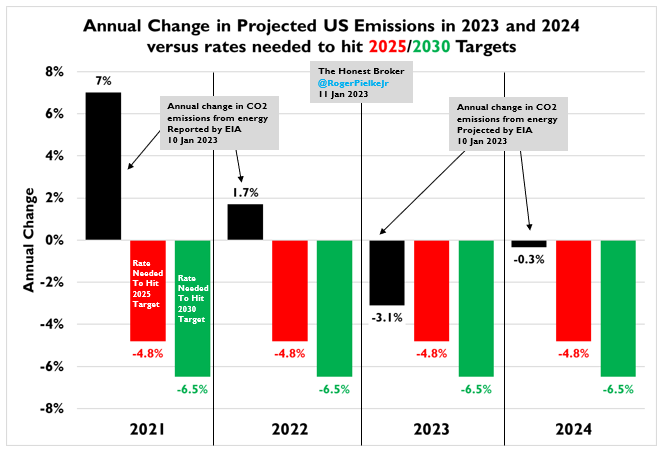Failing Grade: A US Climate Report Card
The Biden Administration is Not Making Sufficient Progress Towards its Emissions Reduction Targets
Several new reports are just out that allow for a quantitative evaluation of progress by the United States under the Biden Administration towards its emissions reduction targets under the Paris Agreement. Despite all of the froth associated with the passage of the Inflation Reduction Act in 2022, according to the latest data from the U.S. government, whoever is sworn in as president in January, 2025 will face an enormous emissions reduction challenge.
These three new reports were released yesterday:
U.S. Energy Information Agency Short-Term Energy Outlook (US EIA)
Preliminary US Greenhouse Gas Emissions Estimates for 2022 (Rhodium Group)
U.S. Power Generation: 2022 Review (Enersection)
The analysis that follows relies on the data and projections found in these reports. First, the figure below shows where the U.S. stood at the end of 2022 with respect to achieving its 2025 and 2030 emissions reductions commitments under the Paris Agreement.

The figure also shows that the U.S. will need to achieve an annual rate of reduction in emissions of about 4.8% +/- to hit its 2025 target and about 6.5%/year to hit its 2030 target.
The U.S. Energy Information Agency (of which I am a huge fan) is the federal agency with responsibility for projecting energy outlooks in the short and long terms. The Figure below summarizes the EIA’s latest projections for carbon dioxide emissions, which we can compare to the annual rates of emissions reductions necessary to hit the policy targets.

The figure above, which is based on data released just yesterday — well after the passage of the Inflation Reduction Act of 2022 — indicates that after a projected modest reductions in emissions in 2023, emissions reductions are expected to come almost to a halt in 2024. (Note that the figure compares U.S. carbon dioxide emissions from fossil fuels with projected rates calculated based on total greenhouse gas emissions — these are typically almost identical. I’m happy to discuss the details in the comments.)
Overall, during the four years of the Biden Administration, carbon dioxide emissions from energy are projected to have decreased by just 1.8% from 2021, which was the rebound year following the pandemic, thus offering a generous baseline.
The bottom line here is that the U.S. seems all but certain to miss its 2025 emissions reduction target and with each passing day, achievement of its 2030 target gets further and further out of reach.
As I have often noted here, discussions of climate are frequently detached from empirical reality. So I suppose some might be able to continue to pretend that U.S. emission reduction targets might still be met. The good news that accompanies short-term targets is that we will not have to wait long to find out.
I welcome challenges and different points of view. Matters of policy (especially future policy) are always legitimate subjects for debate and discussion. I’d welcome especially hearing from people who think that the U.S. can hit its targets, and a defense of that position with projected rates of emissions reductions and decarbonization.
Thanks for reading! Please share around. New subscribers are welcomed at any level.





So, lets be clear. These are not 'US targets'. These are the targets of the Biden administration. And pretty much no one else.
A 50% reduction. by 2030 is unimaginable in the first place. And its a good thing that we are not on track for that because the only way to achieve it would be shut down the economy and blackout power to tens of millions of people. There is no evidence I have seen that suggests that such an extreme draconian reduction in emissions is needed, and even less evidence that it is possible. The problem seems to be that wild eyed graduates of certain U of California campuses with shaggy hair and floppy sandals believe things because they believe them. Which opens the door to why the broader question (way beyond this forum): Why do people believe things?